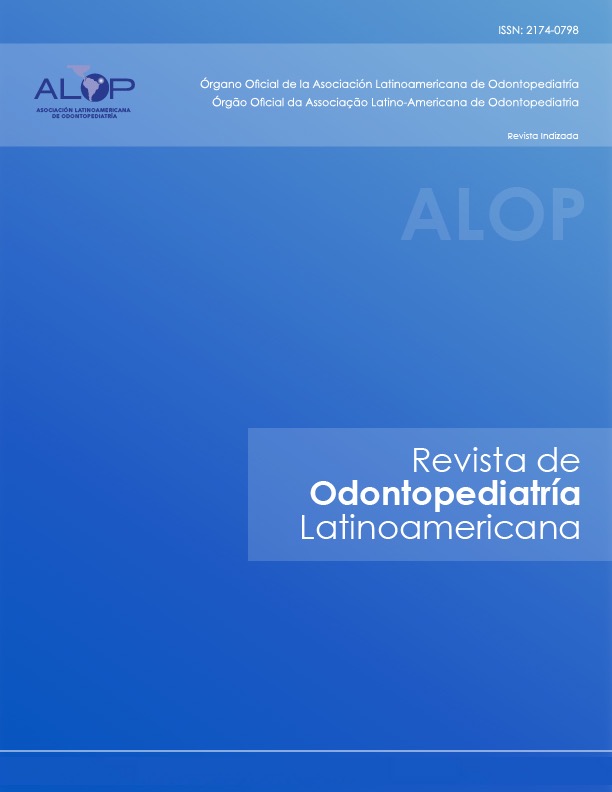Prevalence of oral papillomas in Brazilian children: a retrospectivestudy of biopsied lesions
DOI:
https://doi.org/10.47990/jkv7y994Keywords:
human papillomavirus, mouth, children, Pediatric dentistry, prevalenceAbstract
Introduction: Human papillomavirus (HPV) is an etiologic factor for several diseases of the oral
mucosa and skin that can undergo a malignant process. Vaccination is the most important form of prevention, with girls being vaccinated between the ages of 9 and 13 and boys between the ages of 11 and 13. There is still no consensus on the prevalence of the HPV virus in children. Aim: To review the prevalence of HPV in children aged 1 to 13 years based on a database of reports of biopsied lesions diagnosed with papilloma analyzed in a national reference laboratory. Material and methods: Anatomic-pathologic reports of biopsies received at the Oral and Maxillofacial Pathology Laboratory of the Faculty of Dentistry of the College of São Paulo were analyzed over a 20-year period, between 2002 and 2022. Information on gender, lesion location and diagnostic hypotheses was also collected. Results: In a database of 93,950 reports, the age group analyzed accounted for 4,203 and 99 (2.3%) were diagnosed with papilloma. The proportion of male and female reports was similar at 50.5% and 49.5% respectively. The most common location of the lesion found was the lip region (48%). The most frequently cited diagnostic hypotheses were epulis and verruca vulgaris. Conclusion: The prevalence of papillomas in Brazilian children aged 1 to 13 years was 2.3%. Early diagnosis and advice on HPV vaccination can prevent and avoid exacerbation of the disease. Recognizing the clinical features of lesions is essential for correct diagnosis and early intervention and counseling.
References
Fiorillo L, Cervino G, Surace G, De Stefano R, Laino L, D'Amico C, et al. Human Papilloma Virus: Current Knowledge and Focus on Oral Health. Biomed Res Int. 2021;2021:6631757.
Rezende KM, Moraes Pde C, Oliveira LB, Thomaz LA, Junqueira JL, Bonecker M. Cryosurgery as an effective alternative for treatment of oral lesions in children. Braz Dent J. 2014;25(4):352-6.
Szydlowski J, Jonczyk-Potoczna K, Pucher B, Buraczynska-Andrzejewska B, Prauzinska M, Kolasinska-Lipinska J, et al. Prevalence of human papillomavirus (HPV) in upper respiratory tract mucosa in a group of pre-school children. Ann Agric Environ Med. 2014;21(4):822-4.
Syrjanen S, Rintala M, Sarkola M, Willberg J, Rautava J, Koskimaa H, et al. Oral Human Papillomavirus Infection in Children during the First 6 Years of Life, Finland. Emerg Infect Dis. 2021;27(3):759-66.
Rezende KM, de Barros Gallo C, Nogueira GP, Corraza AC, Haddad AE, Gallottini M, et al. Retrospective study of oral lesions biopsied in babies and toddlers. Oral Dis. 2023.
Syrjanen S, Puranen M. Human papillomavirus infections in children: the potential role of maternal transmission. Crit Rev Oral Biol Med. 2000;11(2):259-74.
Ardekani A, Taherifard E, Mollalo A, Hemadi E, Roshanshad A, Fereidooni R, et al. Human Papillomavirus Infection during Pregnancy and Childhood: A Comprehensive Review. Microorganisms. 2022;10(10).
Smith EM, Swarnavel S, Ritchie JM, Wang D, Haugen TH, Turek LP. Prevalence of human papillomavirus in the oral cavity/oropharynx in a large population of children and adolescents. Pediatr Infect Dis J. 2007;26(9):836-40.
Walhart T. Parents, adolescents, children and the human papillomavirus vaccine: a review. Int Nurs Rev. 2012;59(3):305-11.
Soltanizadeh N, Ameri Shahrabi M, Masjedi MR, Ainy E, Kavousy E, Hashemi SM. Knowledge, attitude, and practice among staff associated with Human Papillomavirus Vaccine of young children in Iran. Med J Malaysia. 2020;75(5):543-7.
MacIntyre CR, Shaw PJ, Mackie FE, Boros C, Marshall H, Seale H, et al. Long term follow up of persistence of immunity following quadrivalent Human Papillomavirus (HPV) vaccine in immunocompromised children. Vaccine. 2019;37(37):5630-6.
Jones AV, Franklin CD. An analysis of oral and maxillofacial pathology found in adults over a 30-year period. J Oral Pathol Med. 2006;35(7):392-401.
Vale EB, Ramos-Perez FM, Rodrigues GL, Carvalho EJ, Castro JF, Perez DE. A review of oral biopsies in children and adolescents: A clinicopathological study of a case series. J Clin Exp Dent. 2013;5(3):e144-9.
Cavalcante RB, Turatti E, Daniel AP, de Alencar GF, Chen Z. Retrospective review of oral and maxillofacial pathology in a Brazilian paediatric population. Eur Arch Paediatr Dent. 2016;17(2):115-22.
Koutsaftiki C, Mammas IN, Papatheodoropoulou A, Koutsounaki E, Theodoridou M, Spandidos DA. Paediatric Virology and the indisputable value of prevention. Exp Ther Med. 2019;18(4):3257-9.
Betz SJ. HPV-Related Papillary Lesions of the Oral Mucosa: A Review. Head Neck Pathol. 2019;13(1):80-90.
Rezende KM, Correa FN, Correa JP, Correa MS, Bonecker M. Histogenesis and clinical analysis of 2 cases of congenital gingival granular cell tumour. J Clin Diagn Res. 2015;9(1):ZD03-5.
Shin MB, Sloan K, Baezconde-Garbanati L, Dang E, Garcia S, Palinkas LA, et al. Multilevel perspectives on school-based opportunities to improve HPV vaccination among medically underserved adolescents: Beyond school entry mandates. Hum Vaccin Immunother. 2023;19(2):2251815.
Aurora T, Cole A, Rai P, Lavoie P, McIvor C, Klesges LM, et al. Multi-component Strategy Improves HPV Vaccination Rates among Adolescents with Sickle Cell Disease. J Pediatr. 2023:113791.
Downloads
Published
Issue
Section
License
Copyright (c) 2024 Latin American Pediatric Dentistry Journal

This work is licensed under a Creative Commons Attribution-NonCommercial-ShareAlike 4.0 International License.























